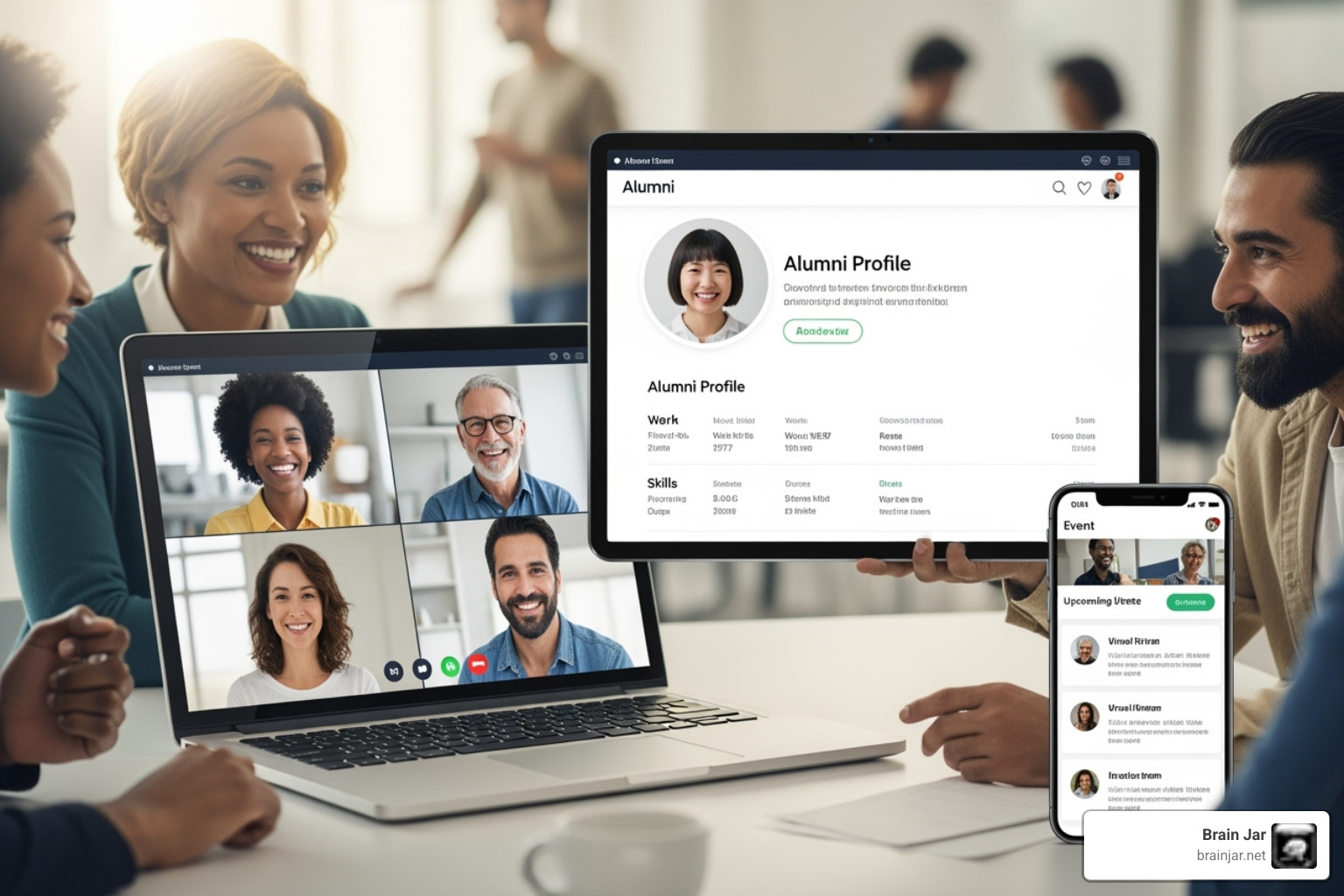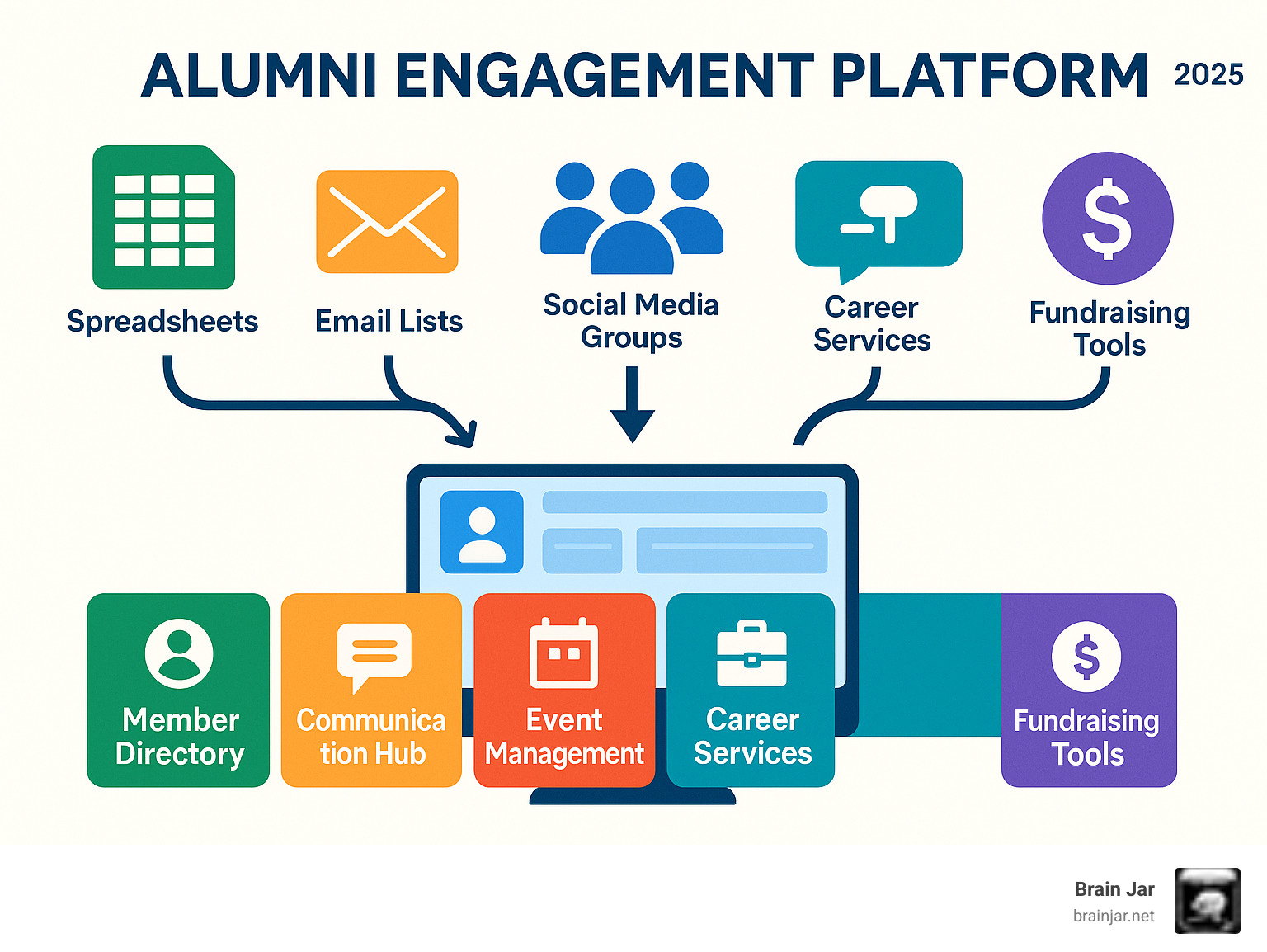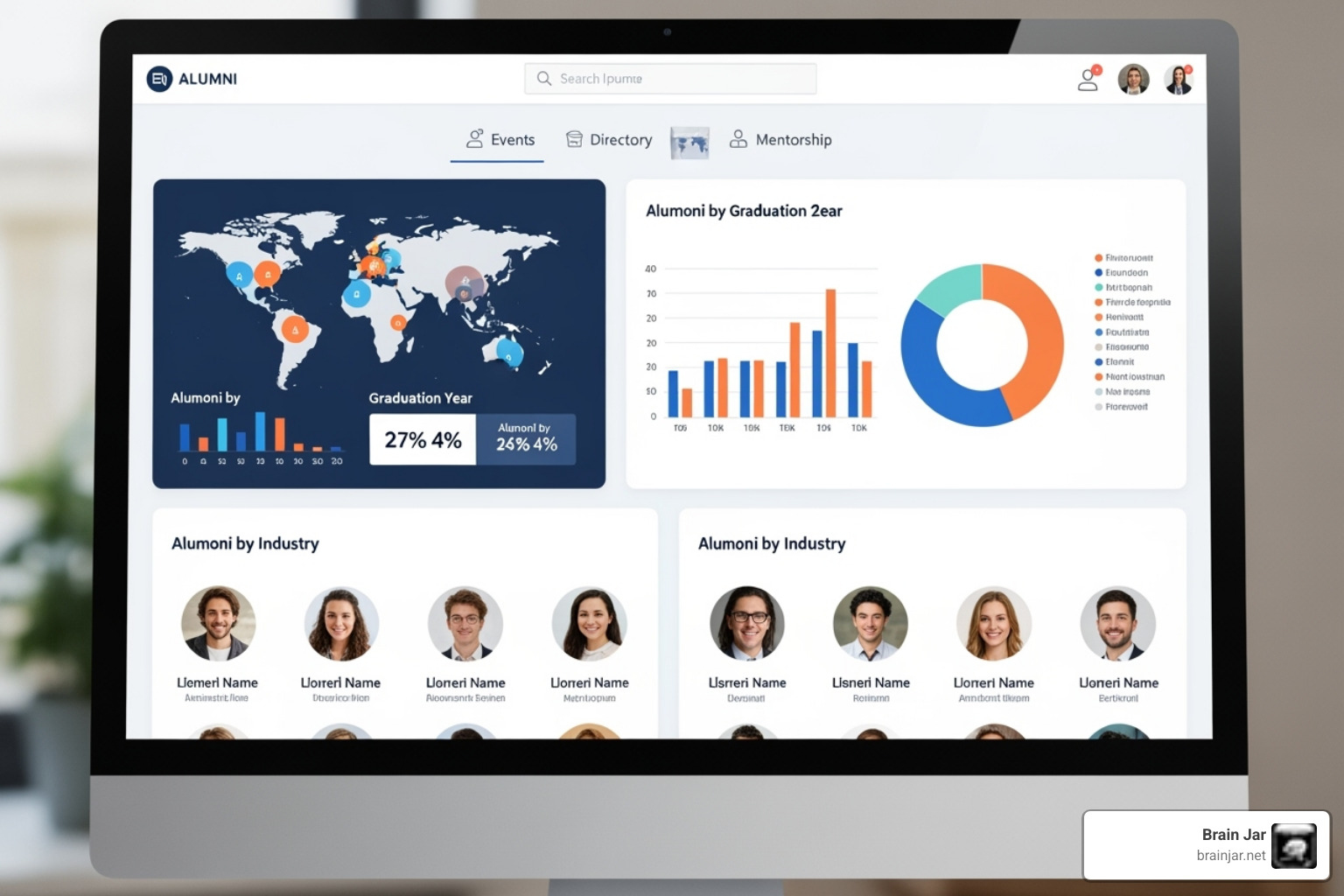Why Alumni Engagement Platforms Are Changing How Institutions Connect

An alumni engagement platform is a comprehensive digital solution that centralizes alumni data, facilitates networking, manages events, and integrates fundraising tools to build stronger, more active alumni communities.
Key components of an alumni engagement platform:
- Member Directory – Searchable database with advanced filtering
- Communication Tools – Automated email campaigns and messaging
- Event Management – Registration, ticketing, and attendance tracking
- Career Services – Job boards, mentorship matching, and networking
- Fundraising Integration – Donation pages and campaign management
- Analytics Dashboard – Engagement metrics and ROI tracking
Most educational institutions still manage their alumni relationships through spreadsheets, disconnected email lists, and fragmented social media groups. This scattered approach creates missed opportunities and leaves valuable relationships untapped.
The numbers tell the story: engaged alumni are 340% more likely to give, and institutions using modern platforms have seen 36% increases in event and membership revenue within their first year. With the alumni software market growing from $465 million in 2023 to a projected $1.4 billion by 2030, it’s clear that institutions are recognizing the need for better solutions.
Modern platforms solve three critical problems:
- Data silos that prevent personalized outreach
- Limited engagement due to outdated tools
- Missed revenue from disconnected fundraising efforts
I’m HJ Matthews, Business Development Manager at Brain Jar, and over my 15 years in digital marketing, I’ve helped organizations across multiple industries leverage technology to build stronger communities. Alumni engagement platforms represent one of the most impactful investments an institution can make in its long-term success.

Why a Unified Platform is a Game-Changer for Alumni Relations
Managing alumni relationships with scattered tools is like trying to conduct an orchestra where half the musicians are in different rooms. You might hear some beautiful notes, but you’ll never create a symphony.
Most institutions today are stuck in this fragmented reality. They’re juggling spreadsheets for contact information, Facebook groups for community discussions, separate email platforms for newsletters, and yet another system for event management and donations. This disjointed approach doesn’t just frustrate administrators—it creates a choppy, inconsistent experience for alumni who deserve better.
The shift toward unified solutions is happening fast, and the numbers prove it. The alumni software market is projected to grow from $465 million in 2023 to $1.4 billion by 2030. That’s not just growth—that’s institutions everywhere recognizing that their current approach isn’t working.
A unified alumni engagement platform moves far beyond simple data storage. It creates a living, breathing ecosystem where alumni feel genuinely valued and connected to their alma mater’s ongoing story. When institutions make this switch, the results speak for themselves. Some have seen up to 36% increases in event and membership revenue after implementing a modern platform.
This isn’t just about making life easier for your staff (though it certainly does that). It’s about open uping new levels of engagement that were impossible with fragmented tools.
Fostering Lifelong Connections
Here’s where alumni engagement platforms truly shine: they make personalization at scale actually possible. Gone are the days of sending the same generic newsletter to every alumnus and hoping something sticks.
A unified platform tracks every meaningful interaction. When Sarah attends a career networking event, volunteers for homecoming, or mentors a current student, that information becomes part of her complete profile. When Mike updates his job title, participates in a webinar, or makes a donation, those touchpoints build a richer understanding of his interests and engagement patterns.
This 360-degree view transforms how you communicate. Instead of mass emails, you can send targeted invitations that actually matter to each person. The environmental science graduate gets invited to the sustainability summit. The marketing professional receives networking opportunities in their industry. The parent alumnus hears about family-friendly campus events.
This level of personalized engagement creates genuine connection. Alumni stop feeling like just another name in a database and start feeling like valued members of an ongoing community. That sense of belonging is what turns occasional participants into lifelong advocates.
Breaking Down Data Silos
Picture your current setup: the alumni office has their database, advancement maintains their donor records, and career services keeps their own professional networking information. Each department holds pieces of the puzzle, but nobody sees the complete picture.
This fragmented approach creates real problems. Contact information gets outdated in one system but not others. Alumni receive duplicate communications or, worse, conflicting messages. Staff waste hours trying to reconcile different datasets, often introducing new errors in the process.
An alumni engagement platform eliminates these headaches by serving as your single source of truth. All alumni data lives in one centralized location where every department can access the same accurate, up-to-date information. When someone updates their contact details, that change appears everywhere instantly.
This centralized approach dramatically improves operational efficiency. Your staff stops playing data detective and starts focusing on what really matters: building relationships and creating valuable experiences for your alumni community.
The platform also integrates seamlessly with your existing systems. Whether you’re using Blackbaud, Salesforce, or another CRM, a quality platform connects directly to enrich your constituent records without creating new data silos.
For deeper insights into how this market is evolving, the Alumni Management Software Market Size, Share & Growth Analysis provides valuable context on these trends.
Core Features of an Effective Alumni Engagement Platform

Think of an effective alumni engagement platform as the Swiss Army knife of community building. It’s not just a fancy digital address book – it’s a comprehensive toolkit that grows with your alumni throughout their entire journey. The best platforms seamlessly blend community hubs, career development resources, fundraising tools, and event management into one cohesive experience that actually adds value to people’s lives.
These features don’t work in isolation. They’re designed to complement each other, creating a network effect where each interaction strengthens the overall community. When alumni find genuine value in the platform – whether through professional connections, career advancement, or meaningful engagement opportunities – they naturally become more invested in their relationship with the institution.
Community and Networking Tools
The magic happens when alumni can easily find and connect with each other. A well-designed member directory with advanced search filters turns “I wonder what happened to…” into meaningful reconnections. Alumni can search by graduation year, location, industry, or even that obscure philosophy club they belonged to in college.
But the real power lies in affinity groups and discussion forums. These dedicated spaces give alumni permission to geek out about their passions – whether it’s a regional chapter planning local meetups, industry-specific groups sharing career insights, or hobby enthusiasts bonding over shared interests. These conversations build the kind of authentic relationships that last.
Here’s something that might surprise you: 65% of emails are now opened on mobile devices. That means if your platform isn’t mobile-friendly, you’re essentially invisible to most of your community. The best platforms recognize that alumni are busy people who engage on the go, making mobile accessibility not just nice to have, but absolutely essential.
Career and Professional Development
Let’s face it – one of the biggest reasons alumni stay connected is because they want their alma mater to continue adding value to their careers. Smart platforms deliver on this expectation through robust job boards where alumni can both post opportunities and find their next career move.
The mentorship component is where things get really interesting. Automated mentor matching takes the awkwardness out of networking by connecting people based on shared interests, industries, or career goals. The numbers speak for themselves: 79% of alumni are happy with opportunities to mentor students, and 80% are satisfied with networking opportunities provided through their institution’s platform.
Beyond connections, effective platforms offer practical career resources like resume builders, interview prep materials, and professional development webinars. Some even feature alumni-owned business directories, creating a marketplace that keeps money and opportunities within the community. It’s career support that actually makes a difference in people’s professional lives.
Fundraising and Advancement
Here’s the truth about fundraising: people give to causes they feel connected to. An alumni engagement platform creates those connections naturally, making fundraising feel less like asking for money and more like inviting people to be part of something meaningful.
The technical side is equally important. Integrated donation pages make giving seamless – no redirecting to clunky external sites or hunting down donation forms. Recurring giving options turn one-time donors into sustained supporters, while campaign tracking and donor analytics help institutions understand what resonates with their community.
The results are striking: engaged alumni are 340% more likely to give. When alumni feel genuinely connected to their institution and see the tangible impact of their support, generosity follows naturally. The platform becomes a bridge between engagement and advancement, turning community participation into lasting institutional support.
Choosing the Right Platform: Key Considerations for Your Institution

Think of selecting an alumni engagement platform like choosing a partner for a long-term relationship. You want someone reliable, who shares your values, and who’ll grow with you over time. This isn’t just a software purchase – it’s a strategic investment that will shape how your institution connects with its graduates for years to come.
The decision shouldn’t be made lightly or based solely on flashy demos. Instead, it needs to be grounded in your institution’s unique strategic goals, your existing technical setup, and the real-world needs of everyone who’ll use it daily. That means considering both your hardworking administrators who’ll manage the platform and the diverse alumni community who’ll hopefully accept it.
Aligning Features with Your Goals
Before you get swept away by impressive feature lists, take a step back and ask yourself: what does success actually look like for our alumni program? This might seem obvious, but you’d be surprised how many institutions skip this crucial step and end up with platforms that don’t match their priorities.
Maybe you’re laser-focused on increasing annual donations and need robust fundraising tools with donor analytics. Perhaps boosting event attendance is your main concern, which means event management features should top your list. Or maybe you’re all about facilitating career connections, especially for recent graduates, making mentorship matching and job boards essential.
Your answers will help you identify your Key Performance Indicators (KPIs) and determine which features are truly must-haves versus nice-to-haves. Don’t forget to think about scalability too. Your alumni base will grow, and your strategic needs will evolve. Choose a platform that can adapt and expand with you, rather than one you’ll outgrow in a few years. Future-proofing your investment now saves headaches down the road.
Technical Requirements and Integrations
Here’s where things get a bit technical, but bear with me – this stuff matters more than you might think. Your alumni engagement platform needs to play well with your existing digital tools, not create more isolated data islands.
The big question is: how will this platform connect with your current CRM integration systems like Blackbaud or Salesforce? These systems often hold your most valuable constituent data, so seamless integration is non-negotiable. You’ll also want to consider your Student Information System (SIS) – how will student data flow into the alumni platform once someone graduates?
Ask potential vendors about API access, which allows for custom connections between different systems. And here’s a big one: data migration support. Moving years of alumni information from spreadsheets or old systems can feel overwhelming. Make sure your vendor offers comprehensive help to make this transition as smooth as possible. Trust me, you don’t want to tackle this alone.
User Experience and Support
Let’s be real – if your platform is clunky or confusing, people simply won’t use it. The user experience needs to work for everyone, from your busy administrators to your tech-savvy recent grads to your less digital-native older alumni.
Look for an intuitive interface that doesn’t require a computer science degree to steer. Your administrators need to update profiles, manage events, and pull reports without pulling their hair out. Alumni need to find connections, register for events, and update their information easily. With 57% of buyers making decisions without ever talking to a salesperson, that online demo and interface are absolutely critical.
Don’t overlook customer support either. When things go wrong (and they will), you want responsive, knowledgeable help. Ask about response times, dedicated account managers, and training resources.
Here’s a warning from someone who’s seen it all: watch out for hidden fees. Nothing kills enthusiasm like surprise costs, and 66% of users cite unexpected charges as their biggest frustration with software platforms. Get everything in writing upfront, including any costs for additional users, extra storage, or premium features.
Member adoption ultimately determines your platform’s success, so choose something your community will actually want to use, backed by support that ensures it keeps working smoothly.
The Future of Alumni Engagement and Emerging Trends

The technology behind alumni engagement platforms is evolving at breakneck speed, and frankly, it’s exciting to witness. What seemed like science fiction just a few years ago is now becoming everyday reality for institutions serious about their alumni relationships.
We’re not just talking about incremental improvements here. These emerging trends represent fundamental shifts in how we understand and nurture our alumni communities. Staying ahead of these developments isn’t about chasing the latest shiny object—it’s about ensuring your institution remains relevant and continues providing a genuinely modern experience that meets your alumni where they are, not where they were five years ago.
The institutions that accept these trends early will find themselves with a significant competitive advantage. They’ll build stronger relationships, see higher engagement rates, and ultimately create more value for both their alumni and their institution.
The Rise of AI and Hyper-Personalization
Remember when personalized outreach meant inserting someone’s first name into an email? Those days are long gone. Artificial intelligence has moved far beyond buzzword status to become a practical, powerful tool that’s changing how we connect with our graduates.
AI-powered recommendations are now sophisticated enough to automatically suggest relevant connections based on career trajectories, geographic locations, and shared interests. The platform learns from each interaction, becoming smarter about what resonates with individual alumni. If an alumnus consistently engages with entrepreneurship content, the system will prioritize startup events and business networking opportunities in their feed.
Predictive analytics takes this even further by anticipating needs before they’re expressed. The platform might identify alumni who are likely career changers based on their engagement patterns and proactively suggest mentorship opportunities or professional development resources. Automated matching for mentorship programs has become incredibly sophisticated, considering not just industry and experience level, but personality traits and communication styles to create more successful partnerships.
Even chatbots have evolved beyond simple question-and-answer tools. Modern AI assistants can guide alumni through complex processes like updating their profiles, registering for events, or finding specific resources, all while maintaining a conversational, helpful tone that feels genuinely supportive rather than robotic.
Data-Driven Strategies and Measuring ROI
The days of running alumni programs on gut feelings and good intentions are over. Modern alumni engagement platforms come equipped with analytics capabilities that would make a data scientist smile. We can now track engagement metrics that truly matter: login frequency, profile completion rates, event participation, and content interaction patterns.
What makes this particularly powerful is the ability to see the bigger picture. CASE-approved reporting standards ensure that institutions can benchmark their performance against industry standards while maintaining consistency in how they measure success. The dashboards provide real-time insights that help administrators understand not just what happened, but why it happened and what to do next.
A/B testing capabilities allow institutions to experiment with different approaches systematically. Maybe one version of an event invitation generates higher attendance, or perhaps a particular type of content drives more meaningful engagement. These insights, gathered continuously, enable institutions to refine their strategies based on actual behavior rather than assumptions.
The result is a clear demonstration of ROI that resonates with institutional leadership. When you can show exactly how alumni engagement translates to increased donations, higher event attendance, or stronger volunteer participation, securing resources for your programs becomes much easier.
For a deeper dive into how these trends are shaping the broader landscape, the Corporate Alumni Management Trends in 2024 offers valuable insights that often parallel what we’re seeing in educational institutions.
Frequently Asked Questions about Alumni Platforms
What is the difference between an alumni platform and a generic CRM?
This is one of the most common questions we get, and it’s a great one! While both systems manage relationships and data, they’re built for completely different worlds.
A generic CRM is like a sales machine – it’s designed to move prospects through a pipeline, track transactions, and convert leads into customers. It’s all about the sale, the deal, the next quarter’s numbers. Think of it as a tool focused on “What can you buy from us?”
An alumni engagement platform flips that entire approach on its head. Instead of transactions, it’s built around relationships that span decades. Instead of sales pipelines, it creates community spaces where graduates can connect, mentor, and give back. The platform includes features that would seem odd in a regular CRM – things like reunion planning tools, mentorship matching systems, and class notes sections.
The difference is like comparing a shopping mall to a neighborhood community center. Both serve people, but one is designed for quick transactions while the other nurtures long-term relationships and shared experiences. An alumni engagement platform understands that a 1985 graduate might suddenly become active again when their child starts applying to colleges, or that a quiet donor might emerge from someone who’s been volunteering for years.
How can an alumni engagement platform help with fundraising?
Here’s where things get really interesting. An alumni engagement platform doesn’t just ask people for money – it creates the conditions where giving feels natural and meaningful.
Think about it this way: you’re much more likely to support a friend’s cause than respond to a random fundraising letter. The platform works by turning your entire alumni base into a connected community first. When graduates feel genuinely connected to their classmates, current students, and the institution’s mission, they develop what we call “warm feelings” toward giving.
The platform makes this happen in several practical ways. Integrated donation pages appear naturally within the user experience, so when someone reads about a scholarship recipient or sees photos from a recent campus improvement, they can contribute right there in the moment. Peer-to-peer fundraising tools let passionate alumni rally their own networks – and nothing beats a personal ask from someone you actually know.
But perhaps most importantly, the platform provides rich data about who’s most engaged. When someone attends virtual events, participates in mentorship programs, and actively engages with campus news, they’re sending clear signals about their connection to the institution. This allows advancement teams to approach the right people at the right time with the right opportunities. It’s not magic, but it sure feels like it when you see the results.
How do you measure the success of an alumni engagement platform?
Measuring success with an alumni engagement platform is like tracking the health of a living community – you need to look at multiple vital signs, not just one number.
The most immediate indicators are user activity metrics. Are people actually logging in regularly? Are they completing their profiles and staying engaged with content? High activity levels tell you the platform provides real value that keeps people coming back.
Participation rates give you the deeper story. We track everything from event attendance (both virtual and in-person) to mentorship program involvement. When alumni are actively participating in programs, volunteering their time, and joining affinity groups, you know the community is thriving.
Communication effectiveness shows how well your messages resonate. Email open rates, click-through rates, and content engagement reveal whether your outreach efforts are hitting the mark or falling flat.
But the ultimate measure is impact on your institution’s goals. This is where the rubber meets the road – increased donor participation, higher volunteer rates, better career outcomes for recent graduates, and stronger overall alumni satisfaction. Some institutions see donor participation rates increase by over 300% among engaged platform users.
The key is establishing baseline measurements before launch, then tracking progress consistently. What gets measured gets managed, and a thriving alumni community creates measurable value that extends far beyond the platform itself.
Conclusion
The case is clear: investing in a modern alumni engagement platform isn’t just a nice-to-have anymore—it’s become a strategic necessity for any institution serious about building a strong, supportive community that lasts for generations. Throughout this guide, we’ve explored how these platforms work their magic by unifying scattered data into a single, reliable source of truth that powers truly personalized engagement. They deliver real value through career and networking tools, helping your graduates advance professionally while staying connected to peers who share their journey.
But here’s what really matters: these platforms foster genuine human connections. They transform what used to be a dusty, outdated directory into a vibrant, interactive community where alumni actually want to spend time. When people feel valued and connected, amazing things happen—donations increase, event attendance soars, and your institution’s reputation grows stronger.
Now, let’s be honest about something important. A well-designed alumni engagement platform provides the foundation, but it’s your comprehensive digital strategy that truly brings everything to life. The software is just the beginning. The real magic happens when you thoughtfully integrate it into your overall outreach, communication, and advancement efforts. It’s about creating a seamless experience that makes alumni feel like they’re still part of something special.
At Brain Jar, we’ve helped institutions across the country build exactly that kind of strategy—one that maximizes their digital presence and creates lasting community impact. We know how to turn an alumni network into an institution’s greatest asset, and we’d love to help you do the same.
Ready to connect the dots for your institution and open up the full potential of your alumni community? Explore our digital marketing services to find how we can help you create the kind of alumni engagement that transforms lives and strengthens your institution for years to come.
